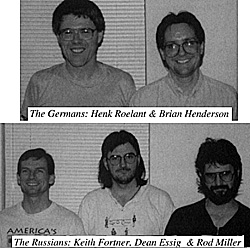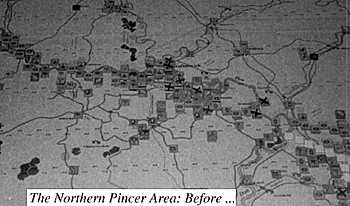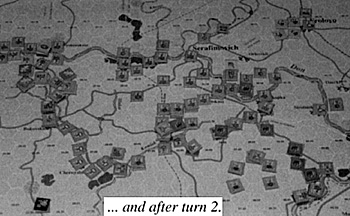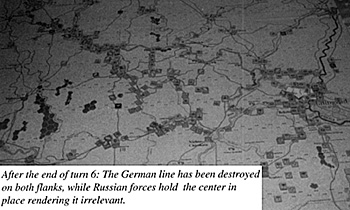 In June, Rod Miller, Keith Fortner and I played a short
weekend game of Enemy at the Gates with Henk Roelant and his
friend, Brian, in Virginia Beach, VA. The game exposed a number of
issues and play techniques that other OCS players might consider and
reflect upon.
In June, Rod Miller, Keith Fortner and I played a short
weekend game of Enemy at the Gates with Henk Roelant and his
friend, Brian, in Virginia Beach, VA. The game exposed a number of
issues and play techniques that other OCS players might consider and
reflect upon.
It is an eye-opening experience to play with others whose techniques, skills, and tricks you do not know like the back of your hand. When we began this game, I was unfamiliar with the players on the other side and, knowing the take-no-prisoners approach of the guys I had played before, I chose to be more cautious than usual. Gradually, I loosened up as I tested the waters to see how much rope the enemy would give me. To my surprise, they let me have all I wanted. As time went on, I found that I was able to take more chances than I could against familiar (and cut-throat) players like Dave Powell and Rod Miller. As play progressed, I began to regret the opportunities I had passed earlier before I relaxed my blanket of caution.
From these experiences, I concluded that when playing new opponents, it is best not to give them the benefit of the doubt. Take a few chances early on and test their mettle. That way, you can flush out their personalities right away and not waste time being too careful. Give them something to jump at and see if they do. Take a little chance and see if they let you get away with it. If they jump at the chance, you will have a better feel for what they are made of-if they do not, see if they will let you get away with a little bit more.
This does not mean do something dumb or get your army blown away--the requirement to play smart still exists. The traps you set should look unintentional ("Oops, he's on the wrong side of the river" or "Damn, I forgot to move that artillery brigade") and you should not set them up so they are clearly traps. Remember, the goal is to ensnare the enemy's psychology, not his units; anything you learn about his skill and aggressiveness is worth both the little units you might lose and the enemy units that get away. A lone Move Mode tank brigade surrounded with Reserve Mode stacks a short way off does not look like an opportunity; it looks like a trap.
 The other learning experience--one that should be
required of those who tend to use the words always, never, and can't
when discussing games-is the discovery that occurs when a you play
others not in your own rut. Generally, players find the absolutes they
had been working under do not fly when faced with an enemy who
refuses to follow the same rut. (Of course, such views might become
stronger if you run into another with the same attitudes as yourselfa
dangerous combination.) That was the case in this game; Henk and
Brian had convinced themselves the Russians did not stand achancenot
only that they could not win, but they might as well not even show up
for the contest. (I really must introduce them to the players in Kansas
City who claim that the Russians cannot be stopped.) Since our
considered opinion is that the Russians, competently and patiently
played, can win the game, the match was set.
The other learning experience--one that should be
required of those who tend to use the words always, never, and can't
when discussing games-is the discovery that occurs when a you play
others not in your own rut. Generally, players find the absolutes they
had been working under do not fly when faced with an enemy who
refuses to follow the same rut. (Of course, such views might become
stronger if you run into another with the same attitudes as yourselfa
dangerous combination.) That was the case in this game; Henk and
Brian had convinced themselves the Russians did not stand achancenot
only that they could not win, but they might as well not even show up
for the contest. (I really must introduce them to the players in Kansas
City who claim that the Russians cannot be stopped.) Since our
considered opinion is that the Russians, competently and patiently
played, can win the game, the match was set.
I will let the observer determine the success of our argument. At the end of Turn 6, the Russians had fatally breached the line on the Don, destroyed the Hungarian army (together with its supporting Germans), cleared and weakly garrisoned the roads to Belgorod, Starobelsk, and Kharkov, and breached the Chir line. The deaths of the 6th Panzer and D'Aosta Motorized Divisions were at hand; the mass of German mobile forces clustered around Kotelnikovko, reeling after attempting a Stalingrad relief operation.
 When playing new folks (or your old cronies), make
sure you are aware of what is going on to your front. By this, I do not
mean watch the enemy move like a hawk to get information you
should not have; you should carry out recons, recons in force, and
probes to determine the status and strength of the enemy to your
front. Make minor attacks to determine enemy reactive capabilities
and to expose tender points (if he reacts with unneeded violence, you
have probably hit a nerve). Try to determine what his reserves
backing his line are
made of. As time went on in our game (as I found out how much rope
I could get), I established a fearsome looking line of reserves--all of
which were single Katyushas and Artillery Brigades-that had the
consistency of paper and the flexibility of the Great Pyramid. Had my
opponents launched a deep probing operation, they would have
exposed this and placed my head on a platter. This did not happen
and they did not call my bluff. Recon vigorously and often.
When playing new folks (or your old cronies), make
sure you are aware of what is going on to your front. By this, I do not
mean watch the enemy move like a hawk to get information you
should not have; you should carry out recons, recons in force, and
probes to determine the status and strength of the enemy to your
front. Make minor attacks to determine enemy reactive capabilities
and to expose tender points (if he reacts with unneeded violence, you
have probably hit a nerve). Try to determine what his reserves
backing his line are
made of. As time went on in our game (as I found out how much rope
I could get), I established a fearsome looking line of reserves--all of
which were single Katyushas and Artillery Brigades-that had the
consistency of paper and the flexibility of the Great Pyramid. Had my
opponents launched a deep probing operation, they would have
exposed this and placed my head on a platter. This did not happen
and they did not call my bluff. Recon vigorously and often.
A bad habit I noticed in our game was the insistence some players placed on large operations that had modest objectives. Not only did they siphon off valuable resources supporting unimportant offensives, but when these operations went sour, they threw good money after bad. Players insisted on supporting a weak hand by throwing more resources after it. Here are two examples.
Our foes launched the Hungarians in an offensive along the Northern Don (a common yet rarely useful tactic that has happened in almost every game we have played). Ostensibly, this limited offensive aimed to threaten Soviet railheads and draw attention and resources away from the main operations around Stalingrad. Strategically, this is a major mistake. The Hungarians (even when reinforced) are not much threat, and the Soviet player can easily destroy them. Dug in on their side of the Don, they only constitute a minor speed bump-on the Russian side, in the open, they are even easier to kill.
 The Soviets are generally in a hurry to set up their
second offensive to attack in that area anyway; having the
Hungarians make a sortie only makes it happen faster. As losses
accumulated, the German player in the area went into denial, assumed
that his failed attacks were generating most of his losses, and
proceeded to flush more fresh formations into (and down) the drain.
By the end of Turn 6 (at right), these forces ceased to exist.
The Soviets are generally in a hurry to set up their
second offensive to attack in that area anyway; having the
Hungarians make a sortie only makes it happen faster. As losses
accumulated, the German player in the area went into denial, assumed
that his failed attacks were generating most of his losses, and
proceeded to flush more fresh formations into (and down) the drain.
By the end of Turn 6 (at right), these forces ceased to exist.
In my front along the Chir, the other German player decided it was high time he gave me a "spanking" (his words), so he took the 6th Panzer Division out to kill a lone 13-3-3 rifle division. Here, a fresh major mobile formation expended its entire turn setting itself into position to blow away a single three-step unit (which it did handily), only to find itself still there when the dust settled and open to dismemberment by the Soviet Tank Army whose web it had breached.
Following the ensnarement of the 6th Panzer, the player then (during the Exploitation Phase) threw good money after bad by sending the D'Aosta Division to "back stop" the impending breach by setting up to the rear of 6th Panzer in Move Mode. These excellent units were mere plumbs for the harvesting if we had been able to continue the game at that point.
When you launch a small or medium operation with German troops, be sure to follow the cardinal rules of Hit Hard, Hit Fast and Break Clean. I learned my lesson (once and for all) about this in an early playtest of EatG when I expended all of Wiking trying to rescue one lone regiment of the division. Sometimes it is best to cut your losses and run--I ended the turn without an entire division because I was worried about getting a regiment killed.
Another cardinal rule of minor operations is that you should not launch such an effort just to have something to do. Define an objective for the operation and stick to it. (Do not let the attack mutate into something larger with wildly diverging goals.) If the attack has a purpose, do it and get it over with. The resources (SPs alone, not to mention vitally important units) our opponents wasted on their limited crossDon operation would have been quite useful in more important future operations. The attitude that it's just an SP or just a token is foolishwaste is waste. The supply (again, not to mention the units ... ) they burned can make or break the German defense later in the game when things get tight-remember, those SS panzers are not worth much without a big supply stockpile.
In the series rules, I preached about garrisons in rear areas. True enough, but there is a difference between a correct garrison and an incorrect one. A correct garrison is large enough to take a brief pounding from roving enemy forces-long enough so heavier forces can arrive to relieve the pressure before the white flag goes up. Less than that and you might as well not bother garrisoning, more than that and you waste troops. In our game, the Germans built two such skyscrapers-one each at Morozovsk and Tatinskyaia. Replete with higher level hedgehogs, these dinosaurs sat there retaining units that would have been more useful garrisoning the nearly deserted cities behind the former Hungarian defenses. The poor positioning of troops left the door wide open for Rod to storm Kharkov.
We experienced the much-vaunted German counteroffensive our opponents claimed would happen south of Stalingrad. In preparation for this Big Event, Keith had his forces resembling nothing as much as a coiled spring. Packed with mobile reserves, forward dumps, redundant supply lines-he was set. Unfortunately for Keith's explosion waiting to happen, the German relief operation was characterized more by whimper than fury. The German infantry around Kotelnikovko advanced to spot for air strikes and a few (largely unsuccessful) hits occurred in a non-Hip Shoot manner. These air strikes went down and the infantry withdrew to safety. No attacks occurred. The pent-up power of the heavy German divisions never made an appearance and there were no overruns. German unit handling in this instance would not have pleased a certain inspectorgeneral of armored troops named Guderian.
I recommended the German players to take a look at my "Putting some Blitz in Your Krieg" article from Ops 7 and suggested that they play some Guderian's Blitzkrieg to learn better German technique.
The game was an interesting experience and I think everyone got something out of it. Many of the lessons I learned I have discussed above. The major point I learned was that you should not discount the difference between players and play groups. Lessons assumed true by a group of players based on their experiences alone are suspect--you must check them with other groups by actual play. It will amaze many in the "always" or "never" crowd what can happen when faced with players who have not fallen into the same rut of thinking.
[Ed. note: I have played EatG with or against Dean, Keith, and Rod, so I know that doing so can be a rough way to learn some good lessons. The OCS is one of those systems in which the variety of options available--choice of modes, different uses of aircraft, overruns versus regular attacks, how much supply to spend on barrages, etc.--makes your individual style of play very important.]
Back to Table of Contents -- Operations #19
Back to Operations List of Issues
Back to MagWeb Master List of Magazines
© Copyright 1995 by The Gamers.
This article appears in MagWeb (Magazine Web) on the Internet World Wide Web.
Other military history articles and gaming articles are available at http://www.magweb.com